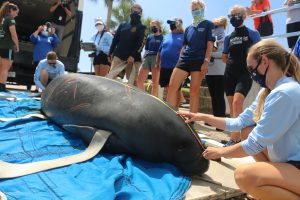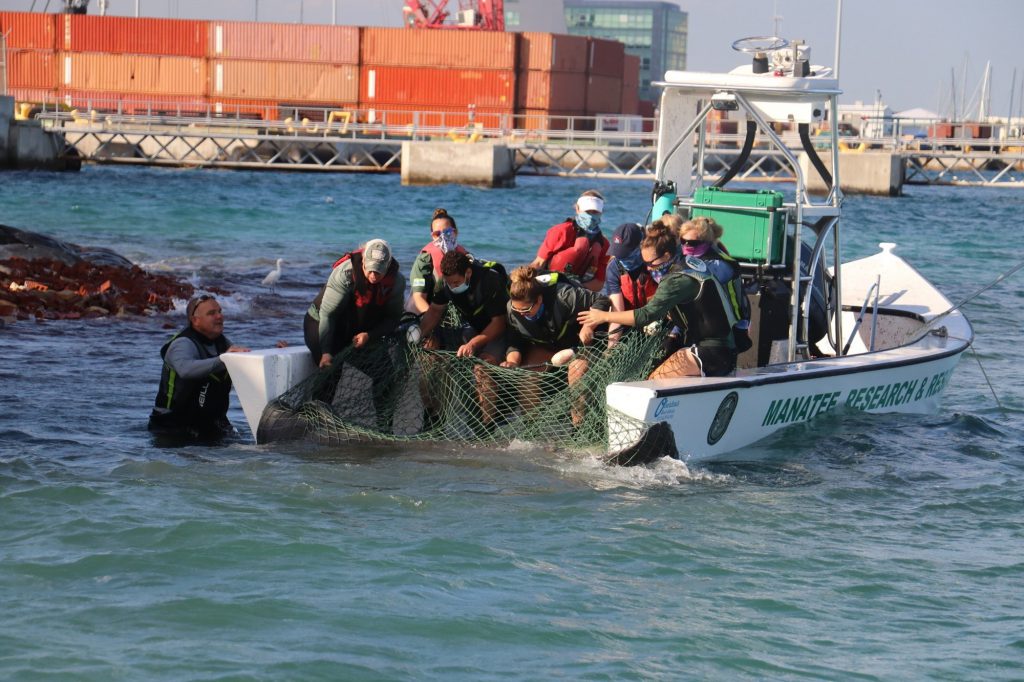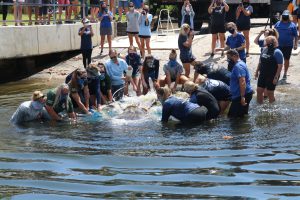Chessie the Manatee Still Making Waves
Wandering Marine Mammal Came to Maryland 27 Summers Ago
Not many visitors to the Chesapeake Bay garner a cult-like following like Chessie. Two books tell his tales, and he has even made a film cameo. His story began nearly two decades ago, back in the summer of 1994, when this nearly 1,100-pound Florida manatee was spotted wandering the waters of the Chesapeake Bay and its tidal tributaries.
At some point during his well-publicized visit, the manatee was given the name Chessie after the Chesapeake Bay and the legendary “sea monster” that resides there. Manatees generally will make the long swim back home to the warm waters of their native Florida. But Chessie stuck around.
As the 1994 summer turned into fall, Chessie continued to do some Bay sightseeing. But his trip came to an abrupt end, when in early October he was caught in an unusual weather system that caused the Bay’s water temperatures to plummet into the 60s. At water temperatures in this range, Chessie’s life was in peril due to cold-stunning, which can occur in marine mammals from late October to early winter. The immediate impacts can cause some species to become slow and unresponsive—and die from the cold, drowning, or boating accidents.
Cindy Driscoll, Maryland Department of Natural Resources state wildlife veterinarian and Marine Mammal and Sea Turtle Stranding Program manager, helped track Chessie before cold-stunning affected him.
“I drove around upper Eastern Shore marinas as sightings came in—to no avail,” Driscoll recalls.

Florida Wildlife Commission staff use a grease marker to highlight Chessie’s scar pattern and take measurements. These data identify Chessie and contribute to manatee health research.
It took an army of staff from the Department of Natural Resources, U.S. Fish and Wildlife Service (USFWS), and the National Aquarium to track Chessie down and save him. Finally, Chessie was found alive near Queenstown in the Chester River.
“Chessie was plopped into the National Aquarium stranding pool, where he stayed for two to three days for us to monitor him,“ Driscoll says. “He was in great shape!”
Arrangements were made with the help of the U.S. Coast Guard to fly him back to Florida. When he arrived in his home state, he was tagged and released by staff and volunteers from SeaWorld Orlando and multiple manatee conservation organizations.
Chessie’s story included a lot of firsts for manatees. He was the first manatee to fly to Florida, the first manatee to ever recuperate at the National Aquarium, and the first tagged manatee to be tracked traveling along the Atlantic coast. He even helped the Maryland Department of Natural Resources develop the first federal set of protocols for northern bound manatee strandings and rescues.
Because of all of this, we have helped the conservation of manatees. USFWS and the U.S. Geological Survey now have rescue and/ or necropsy protocols for northern wandering manatees.
But Chessie’s story doesn’t end there.
Chessie picked up a taste for traveling and even after his close call in the Bay, was spotted several more times along the coast. One summer he was even spotted off the coast of Rhode Island before he swam south.
In February of this year, a male manatee was found emaciated in Riviera Beach, Florida, suffering from pneumonia and malnourishment. Hanging on to life, he was rescued and triaged at SeaWorld Orlando and identified by his scars as none other than Chessie.
After months of intensive care in his pen at SeaWorld, personalized feedings, and lots of love, Chessie gradually gained weight and his health improved drastically. In May of 2021, Chessie was given a clean bill of health and slated to be released yet again into the wild.
The Florida Fish and Wildlife Conservation Commission (FWC) gave Chessie a new monitoring tag (he is known for losing them), and with the help from volunteers, federal agencies and SeaWorld Orlando, the manatee was released in the warm and tranquil waters of North Palm Beach.
Where Chessie will end up is anyone’s guess, but his celebrity status has warmed the hearts of those who follow him. We are all celebrating Chessie’s new chapter.
The Maryland Department of Natural Resources reminds anyone who has seen either a marine mammal or sea turtle in Maryland waters to report it to the state Marine Mammal and Sea Turtle Stranding program at 1-800-628-9944. Anglers, boaters, and beachgoers should especially be on the lookout for these creatures.
Marine mammals are specifically protected by federal law, the Marine Mammal Protection Act. In addition, sea turtles and whales are both protected under the 1973 Endangered Species Act. It is illegal to harass, capture, or collect these marine species, alive or dead, including their bones or any body parts.
dnr.maryland.gov/fisheries
Eric G. Wilson is a Public Affairs Officer for DNR’s Fishing and Boating Services. Article appears in Vol. 24, No. 3 of the Maryland Natural Resource magazine, summer 2021.



 1-888-373-7888
1-888-373-7888 233733
233733